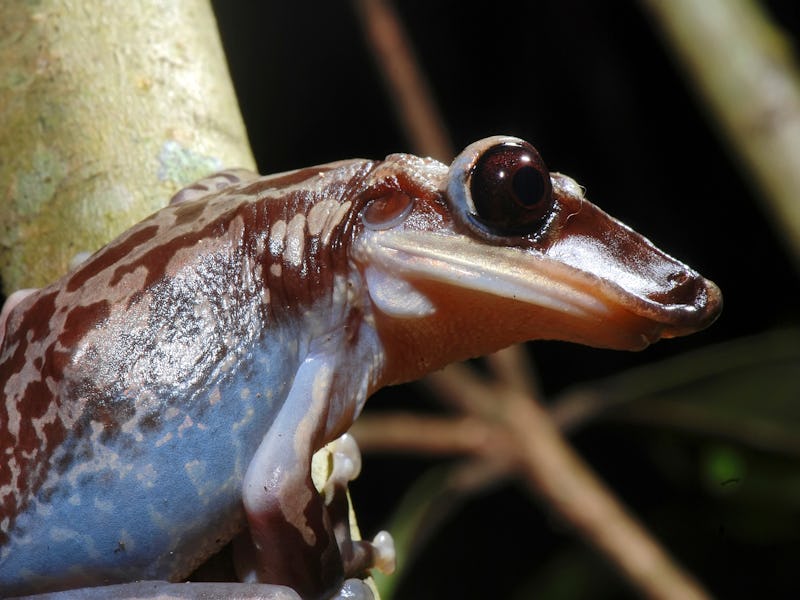Amazingly high-res images reveal hidden details of frogs' evolution
"Their skulls show how strange and diverse frogs can be."

Beneath their slimy skin, some frog species hide a set of secret weapons.
In a new series of incredible high-resolution images, researchers reveal in unprecedented detail just how some amphibians' skulls evolved to make them deadly hunters — and self-defense experts.
In a new study, researchers used CT scans to inspect the skulls of 158 frog species, charting their grooves, ridges, and pits that evolve over time, a process called hyperossification.
The findings reveal new clues about frog evolution. Frog species that prey on birds and mammals, or need a strong defense, develop certain bone traits over time, including helmet-like skulls and venomous spikes.
Those with similar habits for feeding and fending off predators have evolved to have similar traits, the researchers say — even among species whose existence spans millions of years.
"Superficially, frogs may look similar, but when you look at their skulls, you see drastic differences," said lead author Daniel Paluh, a graduate student at the University of Florida, in a statement.
"Some of the weirdest skulls are found in frogs that eat birds and mammals, use their heads as a shield, or in a few rare cases, are venomous. Their skulls show how strange and diverse frogs can be."
The images are stunning:
Anotheca spinosa, a tree frog from Central America, likely uses its skull spikes to protect itself.
Hemiphractus scutatus, a horned frog from South America, can prey on other vertebrates, thanks to its wide skull with a large gape. This species also has fanglike structures on its lower jaw.
You are what you eat (and what eats you)
Bizarrely shaped frog skulls like the one above tend to be associated with frogs that eat other vertebrate animals, like birds, reptiles, rodents, and even other frogs.
Those species often have large, spacious skulls, and jaw toward the back of their skull that allows them to open wide and accommodate their larger prey.
The Argentine Horned Frog, or Pac-Man (Ceratophrys ornata), needs plenty of room to fit big prey in its mouth.
And while most frogs don’t have teeth on their lower jaw, some of these expert predators have fang-like lower protrusions that puncture prey.
Thanks to these traits, some frog species pack an enormous amount of power: Guenther's marsupial frog — which actually does have lower teeth — can eat prey comprising more than half of the frog’s body length.
Meanwhile, species like Bruno's casque-headed frog use their special skulls for defense. With small spikes on their skulls, they use their heads to block predators from entering their burrows, sometimes with the help of venom.
Most frogs share a simple skull shape with a smooth surface. But some species evolved elaborately armored skulls, adapted for capturing large prey or defense.
The new images help researchers understand more about frog evolution, and how they came to have such weird physical traits.
"While the ancestor of all frogs did not have a hyperossified skull, that's how the skulls of quite ancient amphibian ancestors were built," Paluh said.
"These frogs might be using ancient developmental pathways to generate features that characterized their ancestors deep in the past."
Abstract: Frogs (Anura) are one of the most diverse vertebrate orders, comprising more than 7,000 species with a worldwide distribution and extensive ecological diversity. In contrast to other tetrapods, frogs have a highly derived body plan and simplified skull. In many lineages of anurans, increased mineralization has led to hyperossified skulls, but the function of this trait and its relationship with other aspects of head morphology are largely unexplored. Using three-dimensional morphological data from 158 species representing all frog families, we assessed wide-scale patterns of shape variation across all major lineages, reconstructed the evolutionary history of cranial hyperossification across the anuran phylogeny, and tested for relationships between ecology, skull shape, and hyperossification. Although many frogs share a conserved skull shape, several extreme forms have repeatedly evolved that commonly are associated with hyperossification, which has evolved independently more than 25 times. Variation in cranial shape is not explained by phylogenetic relatedness but is correlated with shifts in body size and ecology. The species with highly divergent, hyperossified skulls often have a specialized diet or a unique predator defense mechanism. Thus, the evolution of hyperossification has repeatedly facilitated the expansion of the head into multiple new shapes and functions.